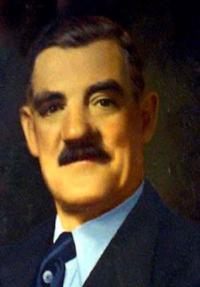
Captain Frederick Bouchard
This year the East Coast tug and barge operator, Bouchard Transportation Company, turned 100 years old. The company’s origin, however, dates back to 1916, and to Captain Frederick Bouchard’s heroism during the worst attack on New York harbor prior to 9/11.
At around 2 a.m. on Sunday morning, July 30, 1916, New York harbor exploded. German saboteurs blew up high explosives at the Black Tom terminal in Jersey City. Black Tom was one of the largest munitions terminals in the country, storing and shipping millions of tons of ammunition and high explosives to the French and the British, who were in the second year of what was then called the “Great War” against Germany and its allies.
The blasts lit the night sky and shook the earth with the force of a Richter scale 5.5 earthquake, as an estimated two million pounds of munitions detonated. The explosions sent bullets and shrapnel flying into the air, seriously damaging the nearby Statue of Liberty. Thousands of windows in the skyscrapers of downtown Manhattan and in Brooklyn were blown out. Windows as far north as Times Square in midtown were also shattered. In Jersey City, the outer wall of City Hall was cracked and the stained glass windows at St. Patrick’s Church were smashed. The blasts were heard and felt for, at least, 90 miles in every direction, as far as Maryland and Connecticut. In Philadelphia, residents were woken up by the explosions.
Captain Fred Bouchard witnessed the explosions while on watch aboard the tug C. Gallagher of the Goodwin, Gallagher Sand Co., at the Long Dock at Erie Basin in Brooklyn. Rather than hunkering down, he steered the tug into the fiery maelstrom and helped to rescue the 4,000-ton steamer Tijoca Rio, and the schooner George E. Elezy of Bath, ME.
In May 1917, the U.S. District Court issued Captain Fred a salvage award, as well as an award for personal bravery, for a total of $9,000. He promptly invested this money to create his own company – Bouchard Transportation Company. And the rest, as they say, is history.
Bouchard is still family owned and run. In the family’s fifth generation, Bouchard Transportation Co., Inc. is the nation’s largest independently-owned ocean-going petroleum barge company, operating a fleet of 26 double-hulled barges and 25 tugs. We wish them only the best as they sail into their second century.

An interesting story, was there much loss of life in the explosion?
We had two WW1 exploding munitions incidents on the River Medway in Kent, England without any enemy interference. There was the battleship HMS Bulwark which was destroyed and sunk and is now a war grave site marked with named buoys, the other was a passenger ship converted to munitions carrier called HMS Irene which for reasons unknown is not a war grave and is just marked with an isolated danger buoy in the middle of the channel near the Thamesport container terminal. Over 800 officers and crew died in the HMS Bulwark and 377 people were killed in the Irene incident.
Pingback: New York History Around The Web This Week | The New York History Blog
Amazingly, given the size of the explosions, fewer than 10 people were killed.
Wow, that was fortunate. I suppose that’s the difference between being on land and being trapped on an exploding ship.